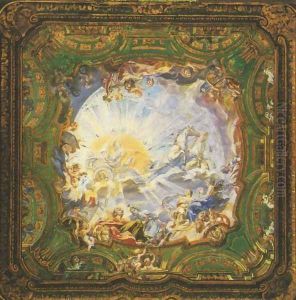Juste-Aurele Meissonnier Paintings
Juste-Aurèle Meissonnier was a French goldsmith, sculptor, painter, architect, and furniture designer, known for his pivotal role in developing the Rococo style, which spread across Europe during the 18th century. Born in 1695 in Turin, which was then part of the Duchy of Savoy, Meissonnier spent most of his career in Paris. He became a master goldsmith and was appointed Orfèvre du Roi (Goldsmith to the King) by Louis XV, a position that allowed him to work closely with the French court and contribute significantly to its artistic ventures.
Meissonnier's artistic output was diverse, ranging from small decorative objects in silver to grand architectural designs. His work is characterized by its dynamic curves, elaborate ornamentation, and often a sense of movement, typical of the Rococo style. He was particularly adept at creating asymmetrical designs that were innovative for his time. His elaborate drawings and etchings circulated widely, influencing the decorative arts throughout Europe. Meissonnier's designs for furniture, silverware, and interior decorations helped to define the French Rococo aesthetic, and his influence extended to porcelain, textiles, and other decorative arts.
Despite his success, relatively few of Meissonnier's works survive today, as many of his metal creations were melted down for their material value. However, his impact on the decorative arts is well recorded in his drawings and engravings. Meissonnier's design book, 'Œuvre de Juste-Aurèle Meissonnier', published posthumously in 1750, the year of his death, remains a critical document for understanding the development and spread of Rococo design. In addition to his role as a designer, he also held the title of architect to the city of Paris, albeit he is less known for architectural accomplishments than for his decorative artistry.
